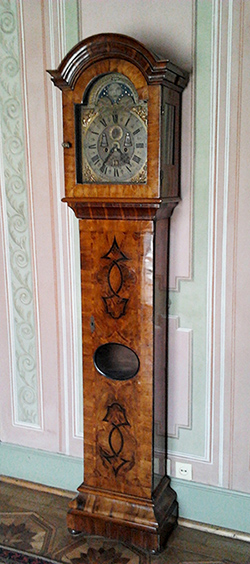My mother-in-law passed away a few months ago and bequeathed to us a houseful of dishes, knickknacks, and furniture. I don’t fault her for that—she could be as contrary as any mother-in-law on earth, but in recent years she had sweetened up considerably, and it wasn’t her intention to leave us with so many decisions to make. In trip after trip—seven hours each way—we winnowed the contents of her home. What made it somewhat interesting were the hundred-dollar bills she had hidden in random vases and sock drawers. (Treasure hunt!) But mostly it was a slog.

The plaster-of-Paris wide-mouthed frog went into the dumpster with his kin. The closetful of tasteful hats went to the local hospice thrift shop. The tools in the garage to a handy neighbor. Old novels to my students. Copper pots and pans to our daughter. The TV sound system to our son. The bronze end tables to consignment. And so on. But inevitably, several loads of armchairs, portraits, and miscellaneous paraphernalia were trailered home to our very own garage. Chief among these precious things was a grandfather clock that had been in the family since, well, long before my wife’s grandfather made his appearance in swaddling clothes.
The grandfather clock was an attractive old gent standing just a little higher than seven feet—tall enough for the NBA but a bit too stationary to be effective in the playoffs. Its face was inscribed with its maker’s name, John Barlow, and the place of its making, Oldham, a town outside of Manchester. (I knew a pair of sisters in college with the last name of Oldham. They were from New Jersey, but their people must have been from England. One of them was very tall and the other always on time. Coincidence? I think not.)
Using these clues, we sleuthed online and discovered that our clock had been made around 1750 or so, at the dawn of the Industrial Revolution—which, we learned, got some of its glimmer in Oldham itself, thanks to the steam-powered cotton mills that were engineered with the help of local clockmakers. Speaking of engineering, the liberal arts college at which I teach just added a major in mechanical engineering, a move I opposed because (quaint thought) I didn’t think engineering was one of the liberal arts. Not that I have anything against engineers. Especially ones with the last name of Barlow.
But back to our clock, wrapped in plastic in our garage and lording over all of the other massed and huddling refugees from another time and place. Would it fit in the house somewhere? My wife and I inspected the walls and corners of each room, looking for a suitable spot. Alas, we found none. Even if we could squeeze it in somewhere, it would dwarf everything else in sight. I finally asked: could we sell it?
“It’s an heirloom!” said my beloved. “It’s been in the family! That would be—so wrong!” Besides, she added, the local antique dealer had said that grandfather clocks were not especially in right now, and ours would fetch only a few hundred dollars.
That’s when a friend happened to mention that our college administration building—a classy old structure that used to be a manor house—once had a grandfather clock in the hallway. That would be nice, my wife thought. We could give the clock away, but it wouldn’t be going too far, since we live right next door to the campus. And because we have both worked at the college since time immemorial, we would almost be giving it to ourselves.
So I sauntered over to the administration building and checked out the cream-white foyer and hallway. Definitely not a good fit. The old wooden clock would stick out like a sore thumb—or more like a throbbing middle finger. Just off the hallway, however, was a high-ceilinged, wood-paneled parlor that plays host to our formal events. Over the years I have arranged more poetry readings in that space than I can count, introducing visiting writers in front of the marble fireplace. So, I peeked inside, and in one corner of that roomy parlor I spotted a very blank wall just begging for a grandfather clock.
We made our offer, the college accepted, and one afternoon, on the stroke of two, I found myself carefully loading the clock like a coffin into the back of a pickup truck for a solemn journey to its final resting place. Once installed, John Barlow’s eighteenth-century creation fit in the room with an unobtrusive dignity. The first people that happened in didn’t even notice it—which, we thought, was just right.
There was one problem, though. In re-hanging the pendulum, I broke off a tiny flange at the top that steadies the motion of the thing. Instead of serenely rocking back and forth, the pendulum now banged crazily into the weights. Reluctantly, we brought it to a timeless halt and comforted ourselves by saying that we wouldn’t want our visiting poets to be interrupted, mid-poem, by the tick-tock and the chiming hours.
But that’s not what my colleagues think. “Don’t worry,” said one of our physics profs. “Our mechanical engineering majors will have that going in no time!”
Paul Willis is a professor of English at Westmont College in Santa Barbara, California. His most recent collection of prose is To Build a Trail: Essays on Curiosity, Love & Wonder (WordFarm, 2018).













